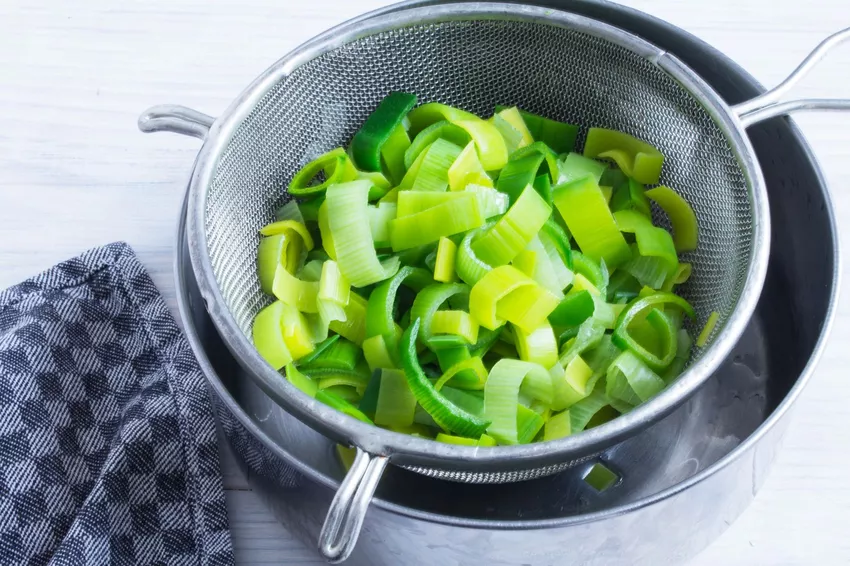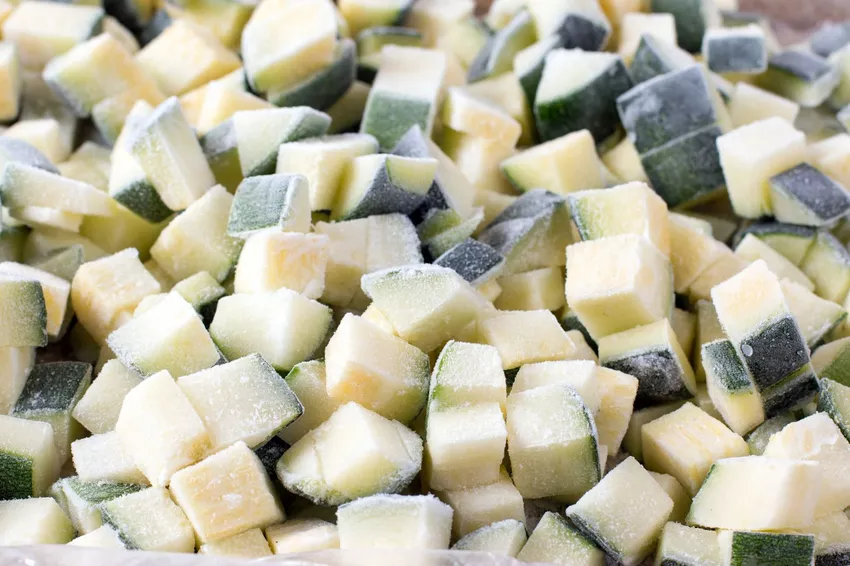A plentiful harvest often leaves something left over that cannot be used immediately. We show you how to freeze fruit and vegetables properly.

Every year the same game takes place in the garden: First you wait impatiently for the first fruits to be harvested, and apparently overnight almost the whole garden is ready for harvest. Soon you won't be able to eat as much as is harvested in the bed - but what to do with all the fruit and vegetables? Freezing is probably the easiest way to preserve vegetables and fruit and save them from the landfill.
Fast, simple and space-saving, it is not only extremely practical, but is also considered the most gentle way of preserving, preserving many he althy ingredients. Here you can find out what you have to consider when freezing and which types of fruit and vegetables are suitable.
Freeze vegetables and fruit: These types are suitable
Unfortunately, not all types of fruit and vegetables can be frozen easily - some types are even not suitable for deep-freezing. On the other hand, berries such as raspberries (Rubus idaeus) or strawberries (Fragaria) are considered to be particularly easy to care for when freezing - these can be frozen easily and stored deep-frozen for a long time. On the other hand, fruit and vegetables that contain water are not particularly suitable for freezing, as they lose their flavor during freezing and become mushy when thawed: bananas (Musa) and apples ( Malus), but also tomatoes (Solanum lycopersicum), potatoes (Solanum tuberosum) or cucumbers ( For this reason, Cucumis sativus) are not suitable for storage in the freezer in their unprocessed state. Most vegetables should be blanched briefly before freezing - carrots (Daucus carota subsp. sativus), peppers (Capsicum ) or mushrooms (Fungi) can be frozen raw without any problems.
What types of fruit can be frozen?
- Berries such as raspberries, blueberries (Vaccinium myrtillus) or strawberries
- Stone fruit such as peaches (Prunus persica), plums (Prunusdomestica) and apricots (Prunus armeniaca) (pitted first)
- Apples and pears (Pyrus) (chopped or processed into a puree)
- Rhubarb (Rheum rhabarbarum) (chopped)
- Banana (only when ripe and without peel)
What types of vegetables can be frozen?
- Peppers, horseradish (Armoracia rusticana) and mushrooms (raw)
- Carrots and courgettes (Cucurbita pepo var. giromontiina) (blanched or raw)
- Peas (Pisum sativum) and beans (Phaseolus vulgaris) (blanched)
- Cabbages such as cauliflower (Brassica oleracea var. botrytis), broccoli (Brassica oleracea var. italica), kohlrabi (Brassica oleracea var. gongylodes) or Chinese cabbage ( Brassica rapa subsp. pekinensis) (blanched)
- Chard (Beta vulgaris subsp. vulgaris), Leek (Allium ampeloprasum subsp. ampeloprasum ), spinach (Spinacia oleracea) and swede (Brassica napobrassica) (blanched)
- Aubergine and kale (fully cooked)

Which fruits and vegetables should not be frozen unprocessed?
- Grapes (Vitis)
- Cucumbers
- Radish (Raphanus sativus var. sativus)
- Tomatoes
- Leaf lettuce (Lactuca sativa var. capitata)
- Garlic (Allium sativum) and Onion (Allium cepa)
Freezing vegetables and fruit in the right packaging
When it comes to packaging for freezing food, opinions differ: some swear by the tried and tested freezer bags, others by cold-stable cans. The main advantage of freezer bags is that you can remove excess air by hand (or even better: with a vacuum sealer), which extends the shelf life of the food and prevents ugly freezer burn. Cold-stable cans, on the other hand, can be stacked much better and thus take up less space. In addition, cans can be reused after thawing, which makes them significantly more environmentally friendly than conventional freezer bags.
But it doesn't matter whether it's a freezer bag or a can - the right filling and portioning is important for both types of packaging. It saves space and is effective for preparing large types of fruit and vegetablescut into pieces or split into florets before freezing. In addition, it is always advisable to think in portions: although most foods can be frozen a second time after thawing without any problems, the quality suffers with each freezing process. It is therefore advisable to freeze several small bags instead of one large bag. You should take special care with the packaging of foods that contain a lot of water - since the water expands when it freezes, boxes and cans that are packed too full can quickly burst when they freeze. Here it is advisable not to fill the packaging to the brim.
Freeze vegetables and fruit correctly: Instructions
Freezing fruit and vegetables is not that difficult. After the harvest, everything that is later to be frozen must first be thoroughly cleaned of soil, dirt and other plant parts such as stems and leaves. We have summarized for you below how to proceed with your harvest.
Freeze berries
Berries are among the easiest fruits to freeze. Washed and freed from their stems, they can already go into the freezer. So that the individual berries do not stick together unattractively during freezing, it is advisable to first place the fruit individually on a tray or baking sheet and then place it in the freezer for a few hours - this way they do not freeze together and keep their shape. Once frozen, the berries are easy to repack into freezer bags or jars.
Tip: The quicker the berries are frozen, the less likely they are to be mushy after thawing.

Freeze stone fruit
Freezing stone fruit is one of the easiest ways to preserve these fruits. However, you should always remove the seeds before freezing, otherwise they will leave a bitter taste in the flesh. Only in the case of cherries (Prunus avium) can the stones remain in the fruit during freezing without any problems. In the case of larger fruits such as apricots or peaches, it is advisable to cut them into smaller pieces to save space. To prevent unsightly brown discolouration from coming into contact with air, a little lemon juice can also be drizzled over the fruit. The fruit can then be packed and frozen.
Freeze apples and pears
Due to their high water content, both apples andpears should not be deep-frozen as a whole fruit either. If you still want to store your harvest frozen, you can process it into mush or compote and store it in this form. However, it is advisable to add some lemon juice here as well - otherwise the purée and compote will quickly become brown and unsightly.
Freeze raw vegetables
A few types of vegetables, including peppers and horseradish, but also mushrooms can be frozen raw without any problems. To do this, the plants must first be washed and (depending on the variety) carefully freed from the stalk. Mushrooms and horseradish can be frozen whole, but peppers, zucchini or carrots should be cut into small pieces before freezing. Carrots and zucchini can also be blanched (as discussed below) to extend their shelf life. Zucchini should be s alted before freezing to keep water out - this will keep the veggies crisp after thawing.

Blanch vegetables before freezing
Most vegetables, such as cauliflower, but also peas or beans, need to be blanched before freezing. First of all, larger vegetables should be cut into smaller pieces so that they can be stored in portions. The vegetables are then briefly blanched in boiling water and then chilled in ice water. Blanching slows down the ripening and rotting processes and thus extends the shelf life of the individual types of vegetables during deep-freezing. The ice water, on the other hand, stops the cooking process and thus preserves the fresh color and vitamins. After blanching, excess water must be thoroughly removed from the vegetables, for example by dabbing with paper towels. The harvest can then find its way into the freezer, well packaged.
What is the right way to freeze fruit and vegetables?
- After harvest, dirt and excess plant parts are removed
- Berries can be frozen immediately after harvest; spread side by side they don't stick in the freezer
- In the case of stone fruit, the pits are removed before freezing and a little lemon juice protects against discolouration
- Due to their high water content, apples and pears should be frozen as a puree or compote
- Some vegetables such as peppers, horseradish and mushrooms can be frozen raw
- Cauliflower, peas and beans are blanched and chilled with ice water before freezing
Freeze vegetables and fruit: note the shelf life
Even if we would like it - unfortunately fruit and vegetables do not keep indefinitely in the freezer. The shelf life varies between the individual types of fruit and vegetables, but also between the methods of preparation. Blanched vegetables have a longer shelf life than raw ones, and fruit with sugar also lasts longer than untreated fruit. As a rule, fruit and vegetables have a shelf life of 6 to 12 months. Cooked food, on the other hand, should only be frozen for a maximum of 3 months. Labeling with the name and date of freezing helps to avoid confusion in the freezer.
Thaw vegetables and fruit properly after freezing
It's not just freezing that has a major impact on the quality of food - defrosting can also affect flavor and consistency. The rule of "quick freeze - slow thaw" often applies. Raw fruit in particular should be thawed as slowly and gently as possible, for example in the refrigerator, in order to preserve the ingredients and consistency. Defrosting is faster in the microwave, but berries and co. become mushy and lose their aroma. The exception to this rule are blanched vegetables: it is best to put them straight from the freezer in the saucepan so that they do not lose their consistency. Incidentally, the cooking time is then about a third shorter than with fresh vegetables.
You can find out here about other methods of preserving fruit and vegetables.